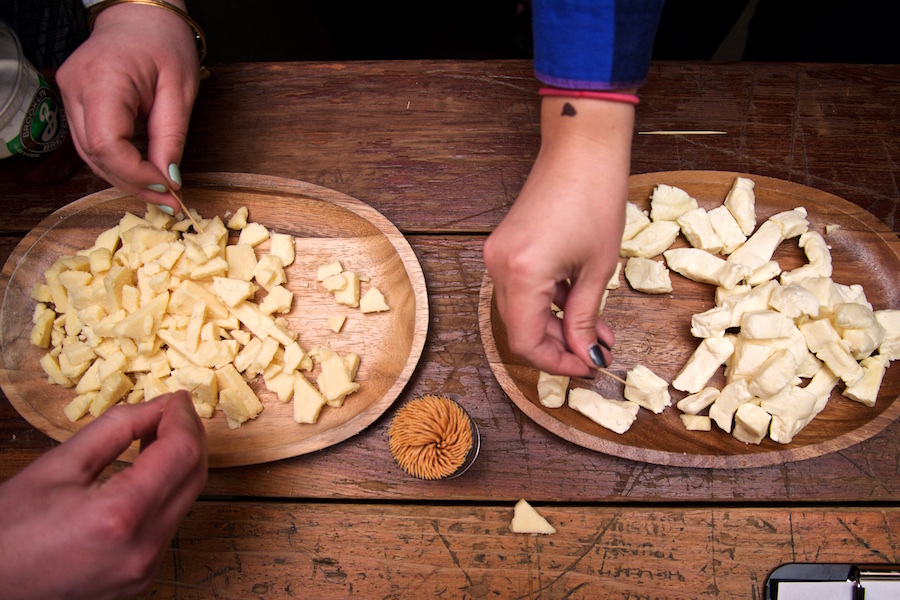Cheese is one of the most beloved foods in the world. It’s very diverse, too, and for those who wanted to know about how to best enjoy cheese, we invited the cheesemongers to Brooklyn Brewery on Wednesday, April 6, to give a crash course entitled “How to Eat Cheese.”
Andrew Torrens, the senior cheesemaker at Beecher’s Handmade Cheese, spoke at length about the considerations required when sourcing milk to make into cheese. He also shared two varieties of Beecher’s cheddar-like Flagship cheese: one aged normally, as well as a platter of curds produced earlier that day. According to Torrens, cheese was initially developed as a method of preserving milk (with the aid of bacteria cultures, rennet and salt) that would otherwise spoil within days, and the source of the milk plays a key role in determining the cheese’s flavor profile.
Because beer is grain, and cows eat grain, it's a better pairing says @BeechersNY. CONTROVERSY!! #ediblebkbrewery
— Edible Brooklyn (@EdibleBrooklyn) April 7, 2016
Goat’s and cow’s milk are the most common, due to their high protein content. Whale milk, on the other hand, contains about 60 percent fat (as opposed to the three percent fat whole milk you’d find at the supermarket) and has the consistency of toothpaste, while human breast milk’s low protein content renders it unsuitable for almost any cheese, except maybe ricotta. Rennet, the key enzymes used during the aging process, traditionally comes from the stomach of the animal that provided the milk (in the case of cow’s milk, the fourth stomach), but vegetarian rennets are also fairly common (Spanish artichokes are a popular source of vegetarian rennet.)
Pasteurization, according to Torrens, provides a kind of blank slate in terms of milk flavor, but raw milk can produce a variety of flavors (not unlike how a wine’s terroir affects the final product) and is perfectly safe if responsibly sourced and handled.
We're the first tasters of the newest, most exclusive cheese from @MurraysCheese called Project X! #ediblebkbrewery pic.twitter.com/ixNChFB2zM
— Edible East End (@EdibleEastEnd) April 7, 2016
Connor Pelcher, wholesale manager at Murray’s Cheese, spoke next about the aging process, which gives cheese its flavor, aroma and texture. Murray’s originally had one cave (which in their case is really a temperature and moisture-controlled room with concrete walls, but traditionally, cheeses in Europe were aged in actual caves) under their West Village shop, but today, they operate five caves out of their LIC wholesale and production facility, each one dedicated to different cheese varieties. Their soft-ripened cheeses, like Brie, age in one room for about a month, while some hard cheddars age for over a year across the hall. The purpose of each cave is to tailor the bacterial activity in each cheese to bring out a produce flavor, and Murray’s experiments with this constantly, turning out new cheese varieties on a regular basis. They even premiered a cheese, currently named Project X, a hard cheese with notes of walnut and pancake.
According to Pelcher, one of the most trying aspects of developing cheeses is the fact that you never really know how it tastes until you’re done. As a result, there’s a very high risk of investing months into something that ultimately turns out to be a “spectacular failure.” However, Pelcher also noted that experimentation beyond Europe’s established styles was key to America developing its own unique cheese culture.
Pair Wine and Cheese brought us an Iowa cheddar paired with a Finger Lakes Riesling #perfectnight #ediblebkbrewery pic.twitter.com/WAkD6KYYSY
— Edible East End (@EdibleEastEnd) April 7, 2016
Last up, Chung Park of Pair Wine and Cheese in Cobble Hill spoke about pairing beverages with cheese, and set off a mini firestorm about whether beer or wine goes better with cheese. While Park supported wine as being able to balance well with cheese (especially if they come from the same reason), Pelcher and Torrens, both wine lovers, passionately defended beer pairings. According to Torrens, since many cows eat grain, it pairs naturally with the grain used in beer production. Additionally, because beer lacks acidity, the beer and wine are better able to match each other’s strengths.
Luckily, all belligerent parties kept their cool in the end and enjoyed some very sharp aged cheddar from Iowa with a Finger Lakes riesling, both provided by Chung.



